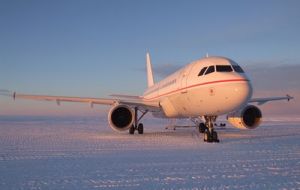MercoPress. South Atlantic News Agency
Warm weather prevents full use of costly Australian Antarctica airfield
 So far this season only one Airbus 319 has been able to land
So far this season only one Airbus 319 has been able to land An Australian airfield in Antarctica at a cost of 40 million US dollars and which was opened just three years ago may have become a short-lived victim of climate change, as unusually warm weather this summer has prevented flights landing there.
So far this summer, only one Airbus A319 flight has landed on Wilkins runway, 70 kilometres southeast of Casey station, compared with 29 over the last two summers. The first flight managed to leave Hobart, Tasmania only last week, reports the Australian media.
Wilkins runway began operating in January 2008 when then Australian Environment minister Peter Garrett joined the first official flight. The airfield was designed to overcome the long sea voyage for personnel working at Casey station.
But this year's experience has raised doubts about the long-term viability of the airstrip. Instead of landing at Wilkins, Australian Antarctic Division staff have landed at the US base, McMurdo, and then been ferried by smaller aircraft to Casey.
A spokeswoman for the division said the combination of warmer temperatures and increased UV strength was affecting the runway. Even flights to the US base have been limited to the colder part of the day, she said.
McMurdo base is located at 72 degrees latitude, compared with 67 for Casey station.
“Being that much further south is advantageous in these warmer-than-usual times,” the spokeswoman said.
But the comment tends to reinforce speculation that another airfield may need to be built further south of Casey station.
When asked what options were being considered to address this problem, the spokeswoman was vague.
“At the end of each season, the Australian Antarctic Division reviews all its operations with a view to making improvements,” she said. “Technology changes all the time and we are open to looking at a range of options.”
The plan to build the airfield was commissioned by the Australian government in 2005. It took more than two years to carve the runway out of the ice.




Top Comments
Disclaimer & comment rulesCommenting for this story is now closed.
If you have a Facebook account, become a fan and comment on our Facebook Page!